U-Pb and Lu-Hf Record of Two Metamorphic Events from the Peixe Alkaline Suite, Brasilia Belt: Textural and Isotopic Complexity in Zircon
Abstract
1. Introduction
2. Geological Setting
2.1. Synthesis of the Rio do Peixe Alkaline Suite Geochronology from the Literature
2.2. Local Context
3. Materials and Methods
3.1. Sample Preparation
3.2. Scanning Electron Microscopy
3.3. U-Pb Geochronological Analyses by ICP-MS-LA
3.4. Lu-Hf Isotope Results
4. Results
4.1. CL Image of Zircon Grains
4.2. U-Pb and Lu-Hf Results in Mega Crystal Zircon of the Peixe Alkaline Suite
5. Discussions
5.1. The Tectonic Environment of Generation of the Peixe Alkaline Suite
5.2. The Record of Two Metamorphic Events (Pb Episodic Losses)
6. Conclusions
Author Contributions
Funding
Data Availability Statement
Acknowledgments
Conflicts of Interest
Appendix A. U-Pb Results of GJ-01 Reference Material
| Spot Number | Pb | Th | U | 207Pb/ | 1 s | 206Pb/ | 1 s | 207Pb/ | 1 s | 206Pb/ | 1 s | 207Pb/ | 1 s | 207Pb/ | 1 s | % | |||
| ƒ 206a | ppm | ppm | ppm | Th/Ub | 235U | [%] | 238U | [%] | Rhod | 206Pbe | [%] | 238U | abs | 235U | abs | 206Pb | abs | Concf | |
| GJ-01 01 | 0.005477 | 30.06283 | 6.08167 | 301.9534 | 0.020141 | 0.824008 | 4.052433 | 0.099336 | 1.834998 | 0.452814 | 0.060162 | 3.61317 | 610.5164 | 11.20296 | 610.282 | 24.73127 | 609.412 | 22.01909 | 100.1812 |
| GJ-01 02 | 0.004145 | 31.3251 | 6.141736 | 316.2859 | 0.019418 | 0.823797 | 3.371622 | 0.099166 | 1.785388 | 0.529534 | 0.06025 | 2.86011 | 609.519 | 10.88228 | 610.1644 | 20.57244 | 612.5609 | 17.51991 | 99.50341 |
| GJ-01 03 | 0.005426 | 31.8749 | 6.458264 | 322.9167 | 0.02 | 0.816388 | 3.393371 | 0.098647 | 1.764413 | 0.519959 | 0.060022 | 2.898588 | 606.4754 | 10.70073 | 606.0314 | 20.56489 | 604.3717 | 17.51825 | 100.3481 |
| GJ-01 04 | 0.000724 | 33.49377 | 6.926545 | 339.2693 | 0.020416 | 0.819743 | 2.369111 | 0.098682 | 1.347151 | 0.568631 | 0.060247 | 1.948813 | 606.6795 | 8.172888 | 607.9049 | 14.40194 | 612.475 | 11.93599 | 99.05375 |
| GJ-01 05 | 0.001065 | 29.70623 | 5.673455 | 299.9333 | 0.018916 | 0.820427 | 2.826345 | 0.099131 | 1.734537 | 0.613703 | 0.060025 | 2.231504 | 609.315 | 10.56879 | 608.2866 | 17.19228 | 604.4581 | 13.48851 | 100.8035 |
| GJ-01 06 | 0.00217 | 31.6 | 6.3 | 319.6013 | 0.019712 | 0.820088 | 2.440273 | 0.098907 | 1.410144 | 0.577863 | 0.060136 | 1.991589 | 607.9974 | 8.573639 | 608.0977 | 14.83925 | 608.4716 | 12.11825 | 99.92206 |
| GJ-01 07 | 0.003769 | 29.03816 | 5.728595 | 289.501 | 0.019788 | 0.844114 | 3.417973 | 0.10145 | 1.359496 | 0.397749 | 0.060346 | 3.13597 | 622.9016 | 8.468324 | 621.4136 | 21.23975 | 615.9987 | 19.31754 | 101.1206 |
| GJ-01 08 | 0.003769 | 29.26287 | 5.70305 | 289.1738 | 0.019722 | 0.846452 | 3.393735 | 0.101661 | 1.28754 | 0.379387 | 0.060387 | 3.140012 | 624.138 | 8.036027 | 622.7 | 21.13279 | 617.4784 | 19.3889 | 101.0785 |
| GJ-01 09 | 0.00236 | 31.92863 | 6.417043 | 325.7854 | 0.019697 | 0.818001 | 2.307615 | 0.098653 | 1.192795 | 0.516895 | 0.060137 | 1.97543 | 606.5078 | 7.234397 | 606.9325 | 14.00566 | 608.5186 | 12.02086 | 99.66956 |
| GJ-01 10 | 0.002379 | 32.21277 | 6.405464 | 324.3235 | 0.01975 | 0.830222 | 2.46714 | 0.100147 | 1.220815 | 0.49483 | 0.060125 | 2.143919 | 615.2693 | 7.511301 | 613.7355 | 15.14171 | 608.0803 | 13.03675 | 101.1822 |
| GJ-01 11 | 0.002018 | 30.98723 | 6.194536 | 314.8791 | 0.019673 | 0.809951 | 2.619744 | 0.097666 | 1.321742 | 0.504531 | 0.060147 | 2.26187 | 600.7173 | 7.939933 | 602.4264 | 15.78203 | 608.8628 | 13.77169 | 98.66217 |
| GJ-01 12 | 0.003178 | 40.17856 | 7.972567 | 404.2939 | 0.01972 | 0.828294 | 2.682013 | 0.100513 | 1.275024 | 0.475398 | 0.059767 | 2.359557 | 617.4118 | 7.872147 | 612.665 | 16.43176 | 595.1566 | 14.04306 | 103.7394 |
| GJ-01 13 | 0.004987 | 24.32899 | 4.896935 | 248.996 | 0.019667 | 0.810259 | 3.292933 | 0.097041 | 1.510095 | 0.458587 | 0.060557 | 2.926264 | 597.0472 | 9.015981 | 602.599 | 19.84318 | 623.5398 | 18.24642 | 95.75125 |
| GJ-01 14 | 0.00414 | 38.87101 | 7.703065 | 390.2066 | 0.019741 | 0.829702 | 3.004319 | 0.100772 | 1.39789 | 0.465294 | 0.059715 | 2.659292 | 618.929 | 8.651947 | 613.4466 | 18.42989 | 593.259 | 15.77649 | 104.327 |
| GJ-01 15 | 0.00265 | 38.45949 | 9.406425 | 385.8371 | 0.024379 | 0.830639 | 2.403451 | 0.099625 | 1.605276 | 0.667904 | 0.060471 | 1.788762 | 612.2084 | 9.827631 | 613.9668 | 14.75639 | 620.4576 | 11.09851 | 98.67046 |
| GJ-01 16 | 0.002694 | 24.74051 | 3.193575 | 253.3655 | 0.012605 | 0.809604 | 3.184728 | 0.098188 | 2.399141 | 0.753327 | 0.059801 | 2.094426 | 603.7836 | 14.48562 | 602.2317 | 19.17945 | 596.3944 | 12.49104 | 101.239 |
| GJ-01 17 | 0.002461 | 23.41418 | 4.962663 | 242.0717 | 0.020501 | 0.813095 | 2.119367 | 0.09809 | 1.031849 | 0.486866 | 0.06012 | 1.851217 | 603.204 | 6.224153 | 604.189 | 12.80498 | 607.8858 | 11.25329 | 99.22983 |
| GJ-01 18 | 0.001472 | 39.78582 | 7.637337 | 397.1309 | 0.019231 | 0.827085 | 1.852878 | 0.099723 | 1.196522 | 0.645764 | 0.060152 | 1.414741 | 612.7872 | 7.332136 | 611.9935 | 11.33949 | 609.0572 | 8.616581 | 100.6124 |
| GJ-01 19 | 0.003337 | 30.25869 | 5.503206 | 301.4032 | 0.018259 | 0.840478 | 2.730154 | 0.101107 | 1.591228 | 0.582834 | 0.06029 | 2.218499 | 620.8932 | 9.879825 | 619.4096 | 16.91084 | 613.9921 | 13.62141 | 101.124 |
Appendix B. U-Pb Results of 91500 Reference Material
| Spot Number | Pb | Th | U | 207Pb/ | 1 s | 206Pb/ | 1 s | 207Pb/ | 1 s | 206Pb/ | 1 s | 207Pb/ | 1 s | 207Pb/ | 1 s | % | |||
| ƒ 206a | ppm | ppm | ppm | Th/Ub | 235U | [%] | 238U | [%] | Rhod | 206Pbe | [%] | 238U | abs | 235U | abs | 206Pb | abs | Concf | |
| 91500 01 | 0.009961 | 8.792298 | 4.853542 | 46.54754 | 0.104271 | 1.835211 | 4.213146 | 0.176322 | 2.739343 | 0.650189 | 0.075488 | 3.201031 | 1046.848 | 28.67676 | 1058.147 | 44.5813 | 1081.53 | 34.62012 | 96.79323 |
| 91500 02 | 0.010988 | 8.596215 | −26.8882 | 42.96674 | −0.62579 | 1.947319 | 6.306179 | 0.1874 | 2.905876 | 0.460798 | 0.075364 | 5.596765 | 1107.277 | 32.17609 | 1097.523 | 69.21178 | 1078.233 | 60.34614 | 102.6937 |
| 91500 03 | 0.00739 | 8.071079 | 1.06961 | 39.96361 | 0.026765 | 1.890144 | 3.552354 | 0.1821 | 2.849466 | 0.802135 | 0.075281 | 2.121263 | 1078.436 | 30.72966 | 1077.633 | 38.28132 | 1076.009 | 22.82497 | 100.2255 |
| 91500 04 | 0.008758 | 8.399928 | 6.302696 | 40.96072 | 0.153872 | 1.913471 | 5.487691 | 0.183427 | 3.707488 | 0.675601 | 0.075659 | 4.045897 | 1085.668 | 40.251 | 1085.795 | 59.58507 | 1086.05 | 43.94047 | 99.96479 |
| 91500 05 | 0.021059 | 5.955597 | −7.68195 | 29.2964 | −0.26221 | 1.942041 | 6.969953 | 0.187465 | 5.828175 | 0.836186 | 0.075134 | 3.822646 | 1107.626 | 64.55439 | 1095.704 | 76.37003 | 1072.094 | 40.98237 | 103.3143 |
| 91500 06 | 0.009631 | 6.485514 | 6.235973 | 33.27502 | 0.187407 | 1.89662 | 4.96548 | 0.183421 | 3.476582 | 0.70015 | 0.074994 | 3.54533 | 1085.638 | 37.74311 | 1079.905 | 53.62247 | 1068.354 | 37.87666 | 101.6179 |
| 91500 07 | 0.018527 | 5.966631 | 118.018 | 29.74039 | 3.968275 | 1.946318 | 6.750591 | 0.185945 | 5.342696 | 0.791441 | 0.075915 | 4.126266 | 1099.372 | 58.73611 | 1097.178 | 74.06603 | 1092.83 | 45.09306 | 100.5987 |
| 91500 08 | 0.014414 | 6.582439 | 4.217703 | 31.60079 | 0.133468 | 2.010495 | 6.354589 | 0.193272 | 4.761473 | 0.749297 | 0.075445 | 4.208228 | 1139.076 | 54.2368 | 1119.058 | 71.11157 | 1080.392 | 45.46534 | 105.4318 |
| 91500 09 | 0.013271 | 7.261859 | 4.198266 | 36.17678 | 0.116049 | 1.917528 | 6.151084 | 0.183603 | 3.87228 | 0.629528 | 0.075746 | 4.779255 | 1086.63 | 42.07737 | 1087.208 | 66.87507 | 1088.365 | 52.01576 | 99.84056 |
| 91500 10 | 0.019002 | 5.969732 | 3.916536 | 29.67938 | 0.131961 | 1.954757 | 6.659129 | 0.186735 | 5.45709 | 0.81949 | 0.075922 | 3.816302 | 1103.666 | 60.22802 | 1100.083 | 73.25593 | 1093.003 | 41.71229 | 100.9755 |
| 91500 11 | 0.002682 | 9.441448 | 19.663 | 44.92839 | 0.437652 | 1.922687 | 4.818485 | 0.18475 | 4.190815 | 0.869737 | 0.075479 | 2.377996 | 1092.87 | 45.80015 | 1089.002 | 52.47339 | 1081.275 | 25.71267 | 101.0723 |
| 91500 12 | 0.025914 | 4.625964 | 10.51357 | 21.27085 | 0.494271 | 2.104767 | 9.327857 | 0.199696 | 7.766245 | 0.832586 | 0.076442 | 5.166659 | 1173.689 | 91.15158 | 1150.367 | 107.3046 | 1106.671 | 57.17794 | 106.0558 |
| 91500 13 | 0.003693 | 11.4477 | 18.6438 | 55.76288 | 0.334341 | 1.929789 | 4.947299 | 0.184519 | 4.546394 | 0.918965 | 0.075852 | 1.950915 | 1091.617 | 49.62921 | 1091.466 | 53.99809 | 1091.165 | 21.2877 | 100.0414 |
| 91500 14 | 0.00283 | 10.546 | 22.49904 | 52.06992 | 0.432093 | 1.908628 | 3.115533 | 0.183301 | 2.658026 | 0.853153 | 0.075519 | 1.625253 | 1084.985 | 28.83917 | 1084.106 | 33.77567 | 1082.339 | 17.59075 | 100.2444 |
References
- Corfu, F. A century of U-Pb geochronology: The long quest towards concordance. GSA Bull. 2013, 125, 33–47. [Google Scholar] [CrossRef]
- Wetherill, G.W. Discordant uranium-lead ages. Part 2. Discordant ages result from the diffusion of lead and uranium. J. Geophys. Res. 1966, 68, 2957–2965. [Google Scholar] [CrossRef]
- Allègre, C.J. Methode de discussion geochronologique Concordia generalisee. Earth Planet. Sci. Lett. 1967, 2, 57–66. [Google Scholar] [CrossRef]
- Krogh, T.E. Improved accuracy of U-Pb zircon ages by selecting more concordant fractions using a high gradient magnetic separation technique. Geochim. Cosmochim. Acta 1982, 46, 631–635. [Google Scholar] [CrossRef]
- Feng, R.; Machado, N.; Ludden, J. Lead geochronology of zircon by LaserProbe Inductively Coupled Plasma Mass Spectrometery (LP-ICPMS). Geochim. Cosmochim. Acta 1993, 57, 3479–3486. [Google Scholar] [CrossRef]
- Bowring, S.A.; Schmitz, M.D. High precision zircon geochronology and the stratigraphic record. Rev. Mineral. Geochem. 2003, 53, 305–326. [Google Scholar] [CrossRef]
- Matzel, J.; Bowring, S.; Miller, R. Time scales of pluton construction at differing crustal levels: Examples from the Mount Stuart and Tenpeak intrusions, North Cascades, Washington. Geol. Soc. Am. Bull. 2006, 118, 1412–1430. [Google Scholar] [CrossRef]
- Dodson, M.H. Closure temperature in cooling geochronological and petrological systems. Contrib. Mineral. Petrol. 1973, 40, 259–274. [Google Scholar] [CrossRef]
- Fryer, B.J.; Jackson, S.E.; Longerich, H.P. The application of laser ablation microprobe–inductively coupled plasma–mass spectrometry (LAM-ICP-MS) to in-situ (U)-Pb geochronology. Chem. Geol. 1993, 109, 1–8. [Google Scholar] [CrossRef]
- Gebaur, D.; Grunenfelder, M. U-Th-Pb dating of minerals. In Lectures in Isotope Geology; Jäger, E., Hunziker, J.C., Eds.; Springer-Verlag: Berlin/Heidelberg, Germany; New York, NY, USA, 1979; pp. 105–131. [Google Scholar]
- Machado, N.; Gauthier, G. Determination of 207Pb/206Pb ages on zircon and monazite by laser-ablation ICPMS and application to study sedimentary provenance and metamorphism in southeastern Brazil. Geochim. Cosmochim. Acta 1996, 60, 5063–5073. [Google Scholar] [CrossRef]
- Košler, J.; Fonneland, H.; Sylvester, P.; Tubrett, M.; Pedersen, R.-B. U-Pb dating of detrital zircons for sediment provenance studies—A comparison of laser ablation ICP-MSand SIMS techniques. Chem. Geol. 2002, 182, 605–618. [Google Scholar] [CrossRef]
- Horn, I.; Rudnick, R.L.; McDonough, W.F. Precise elemental and isotope ratio determination by simultaneous solution nebulization and laser ablationICP-MS: Application to U-Pb geochronology. Chem. Geol. 2000, 164, 281–301. [Google Scholar] [CrossRef]
- Jackson, S.E.; Pearson, N.J.; Griffin, W.L.; Belousova, E.A. The application of laser ablation–inductively coupled plasma–mass spectrometry to in situ U-Pb zircon geochronology. Chem. Geol. 2004, 211, 47–69. [Google Scholar] [CrossRef]
- Gehrels, G.E.; Valencia, V.A.; Ruiz, J. Enhanced precision, accuracy, efficiency, and spatial resolution of U-Pb ages by laser ablation–multi-collector–inductively of Analytical Atomic Spectrometry. Geochem. Geophys. Geosyst. 2008, 24, 1355–1363. [Google Scholar] [CrossRef]
- Cottle, J.M.; Horstwood, M.S.A.; Parrish, R.R. A new approach to single shot laser ablation analysis and its application to in situ Pb/U geochronology: Coupled plasma–mass spectrometry. Geochem. Geophys. Geosyst. 2009, 9, Q03017. [Google Scholar] [CrossRef]
- Ahrens, L.H. Implications of the Rhodesia age pattern. Geochim. Cosmochim. Acta 1955, 8, 1–5. [Google Scholar] [CrossRef]
- Wetherill, G.W. Discordant Uranium-Lead ages, Part I. Am. Geophys. Union Trans. 1956, 37, 320–326. [Google Scholar]
- Pidgeon, R.T.; Nemchin, A.A.; Hitchen, G.J. Internal structures of zircons from Archean granites from the Darling Range batholith: Implications for zircon stability and the interpretation of zircon U-Pb ages. Contrib. Mineral. Petrol. 1998, 132, 288–299. [Google Scholar] [CrossRef]
- Connelly, J.N. Degree of preservation of igneous zonation in zircon as a signpost for concordancy in U-Pb geochronology. Chem. Geol. 2001, 172, 25–39. [Google Scholar] [CrossRef]
- McFarlane, C.R.M.; Connelly, J.N.; Carlson, W.D. Intracrystalline redistribution of Pb in zircon during high-temperature metamorphism. Chem. Geol. 2005, 217, 1–28. [Google Scholar] [CrossRef]
- Reddy, S.M.; Timms, N.E.; Trimby, P.W.; Kinny, P.D.; Buchan, C.; Blake, K. Crystal-plastic deformation of zircon: A defect in the assumption of chemical robustness. Geology 2006, 34, 257–260. [Google Scholar] [CrossRef]
- Ludwig, K.R. ISOPLOT–A Plotting and Regression Program for Radiogenic Isotope Data. Version 2.70; Special Publication No. 1a; Berkeley Geochronology Center: Berkeley, CA, USA, 2000; Volume 91–445, 42p. [Google Scholar]
- Martins, J.P.; Lemos, F.R. Pegmatitos do Complexo Alcalino de Peixe ñ Goias. Master’s Thesis, Universidade Federal do Para, Belém, Brazil, 1981; 101p. [Google Scholar]
- Dardenne, M.A. The Brasília fold belt. In Tectonic Evolution of South America; Cordani, U.G., Milani, E.J., Filho, A.T., Campos, D.A., Eds.; SBG: Rio de Janeiro, Brazil, 2000; pp. 231–263. [Google Scholar]
- Pimentel, M.M.; Fuck, R.A.; Jost, H.; Ferreira Filho, C.F.; Araújo, S.M. The basament of the Brasilia Fold Belt and the Goiás magmatic arc. In Tectonic Evolution of South America; Cordani, U.G., Thomas Filho, A., Campos, D.A., Eds.; SBG: Rio de Janeiro, Brazil, 2000; pp. 195–229. [Google Scholar]
- Pimentel, M.M.; Rodrigues, J.B.; Della Giustina, M.E.S.; Junges, S.; Matteini, M.; Armstrong, R. The tectonic evolution of the Neoproterozoic Brasília belt, central Brazil, based on SHRIMP and LA-ICPMS U-Pb sedimentary provenance data—A review. J. S. Am. Earth Sci. 2011, 3, 345–357. [Google Scholar] [CrossRef]
- Dalziel, I.W.D. Late Proterozoic-Paleozoic geography and tectonics: Review, hypothesis, environmental speculation. Geol. Soc. Am. Bull. 1997, 109, 16–42. [Google Scholar] [CrossRef]
- Trompete, R. Geology of Western Gondwana (2000–500 Ma); Balkema, A.A., Ed.; CRC Press: Rotterdam, The Netherlands, 1994; 350p. [Google Scholar]
- Marini, O.J.; Fuck, R.A.; Danni, J.C.M.; Dardene, M.A.; Lougguércio, R.O.; Ramalho, R. As faixas de dobramentos Brasília, Uruaçu e Paraguai-Araguaia e o Maciço Mediano de Goiás. In Geologia do Brasil; Schobbenhaus, C., Campos, D.A., Derze, G.R., Asmus, H.E., Eds.; DNPM: Brasília, Brazil, 1984; pp. 251–303. [Google Scholar]
- Bartrbosa, O.; Baptista, M.B.; Braun, P.G.; Dyer, R.E.; Costa, L.E. Geologia e Reeursos Minerais do Projeto Brasilia; Relatorio Interno; PROSPEC-DNPM: Brasília, Brazil, 1969; 225p. [Google Scholar]
- Lemos, R.L. Petrologia do Maciço Alcalino de Peixe em Goias. Master’s Thesis, Universidade Federal do Para, Belém, Brazil, 1983; 169p. [Google Scholar]
- Rossi, P.; Andrade, G.F.; Gaspar, J.C. The Peixe (Tocantis, Brazil) Mesoproterozoic corundum-bearing syenite pegmatite complex: Age, considerations on its origin and regional significance. In Congresso Brasileiro de Geologia, Anais, 39; SBG: Rio de Janeiro, Brazil, 1996; Volume 6, pp. 426–428. [Google Scholar]
- Queiroz, H.; Viana, R.R.; Battilani, G.A.; Oliveira, L.L.; Borges GM e Guerra, D.L. Occurrence of Complex Pegmatites in the South of Tocantins State, Brazil; Asociación Geológica Argentina: Autonoma de Buenos Aires, Argentina, 2011; Volume 14, pp. 157–159. [Google Scholar]
- Kitajima, L.F.W.; Ruiz, J.; Gehrels, G.; Gaspar, J.C. Uranium-lead ages of zircon megacrysts and zircon included in corundum from Peixe Alkaline Complex (Brazil). In Proceedings of the III South American Symposium on Isotope Geology, Pucon, Chile, 21–24 October 2001. Extended Abstracts on CD-ROM. [Google Scholar]
- Navarro, G.R.B.; Zanardo, A.; Simões, L.S.A. Rochas metamáficas associadas ao Arco Magmático de Goiás na região de Pontalina-GO. Rev. Bras. Geociências 2007, 37, 18–27. [Google Scholar] [CrossRef]
- Pimentel, M.M.; Fuck, R.A.; Alvarenga, C.J.S. Post-Brasiliano (Pan-African) high-K granitic magmatism in Central Brazil: The role of Late Precambrian-early Palaeozoic extension. Precambrian Res. 1996, 80, 217–238. [Google Scholar] [CrossRef]
- Marques, G.C. Geologia dos Grupos Araí e Serra da Mesa e Seu Embasamento no sul de Tocantins. Master’s Dissertation, Universidade de Brasília, Brasília, Brazil, 2009; 120p. [Google Scholar]
- Polo, H.J.O.; Diener, F.S. Carta Geológica: Folha Mata Azul SD.22-X-DII; Projeto Noroeste de Goiás; CPRM: Rio de Janeiro, Brazil, 2013. [Google Scholar]
- Pereira, A.B. Caracterização dos Granitos e Pegmatitos Peraluminosos, Mineralizados em Sn and Ta, de Monte Alegre de Goiás. 2001. 57f. Master’s Dissertation, Instituto de Geociências, Universidade de Brasília, Brasília, Brazil, 2001. [Google Scholar]
- Griffin, W.L.; Belousova, E.A.; Walters, S.G.; O’Reilly, S.Y. Archaean and Proterozoic crustal evolution in the Eastern Succession of the Mt Isa district, Australia: U–Pb and Hf-isotope studies of detrital zircons. Austr. J. Earth Sci. 2006, 53, 125–149. [Google Scholar] [CrossRef]
- Elhlou, S.; Belousova, E.; Griffin, W.L.; Pearson, N.J.; O’reilly, S.Y. Trace element and isotopic composition of GJ-red zircon reference material by laser ablation. Geochmica Cosmochim. Acta 2006, 70, 158. [Google Scholar] [CrossRef]
- Alves, M.I.; Almeida, B.S.; Cardoso, L.M.C.; Santos, A.C.; Appi CBertotti, A.L.; Chemale, F.; Tavares, A.D., Jr.; Martons, M.V.A.; Geraldes, M.C. Isotopic Composition of Lu, Hf, and Yb in GJ-1, 91500 and Mud Tank reference materials measured by LA-ICP-MS: Application of the Lu-Hf geochronology in zircon. J. Sediment. Environ. 2019, 4, 220–248. [Google Scholar] [CrossRef]
- Reinhardt, F.; Laux, J.; Oliveira, C.; Junges, S. The Santa Terezinha Sequence, Goias Magmatic arc, Central Brazil: Constraints from U-Pb and Sm-Nd Data. In Proceedings of the South American Symposium on Isotope Geology, Punta Del Este, Uruguay, 24–27 April 2006. [Google Scholar]
- Nilson, A.A.; Botelho, N.F.; Ferreira Filho, C.F. Rifteamento crustal Meso-proterozoico no centro de Goias. In Congresso Brasileiro de Geologia, 38, Balneario Camboriu, Anais; SBG: Rio de Janeiro, Brazil, 1994; pp. 258–259. [Google Scholar]
- Pimentel, M.M.; Heaman, L.; Fuck, R.A.; Marini, O.J. U-Pb zircon geochronology of Precambrian tinbearing continental-type acid magmatism in central Brazil. Precambrian Res. 1991, 52, 321–335. [Google Scholar] [CrossRef]
- Rämö, O.T.; Haapala, I. One hundred years of rapakivi granite. Mineral. Petrol. 1995, 52, 129–185. [Google Scholar] [CrossRef]
- Cid, J.P.; Bitencourt, M.F.; Nardi, L.V.S.; Conceição, H.; Bonin, B.; Lafon, J.M. Paleoproterozoic late-orogenic and anorogenic alkaline granitic magmatism from northeast Brazil. Precambrian Res. 2000, 104, 47–75. [Google Scholar]
- Valentin, E.; Botelho, N.F.; Dantas, E.L. Monte Santo suite, an example of Ediacaran-Cambrian deformed alkaline rocks in the Araguaia Belt, Central Brazil. Implications for Western Gondwana evolution. Lithos 2020, 366, 105552. [Google Scholar] [CrossRef]
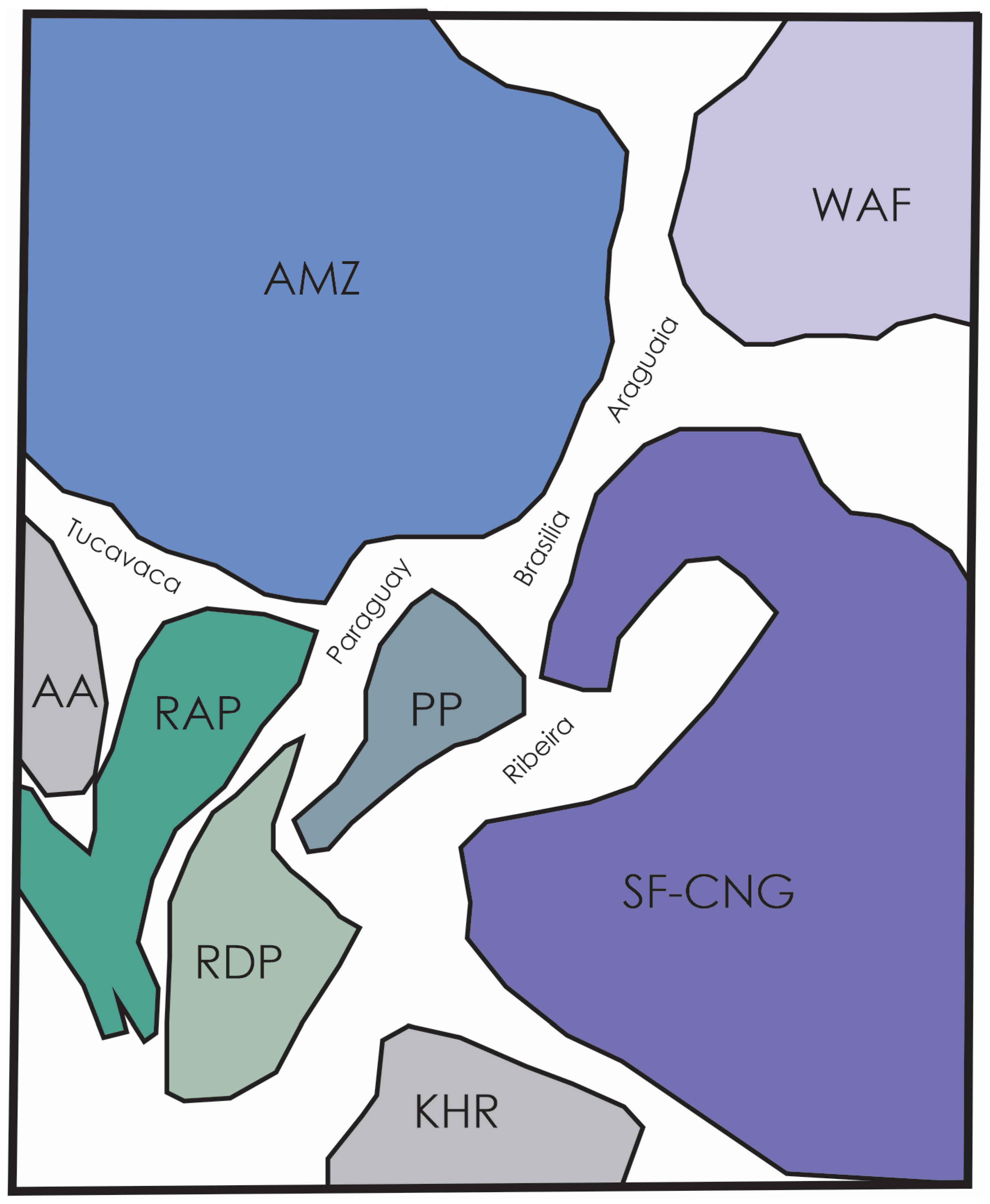
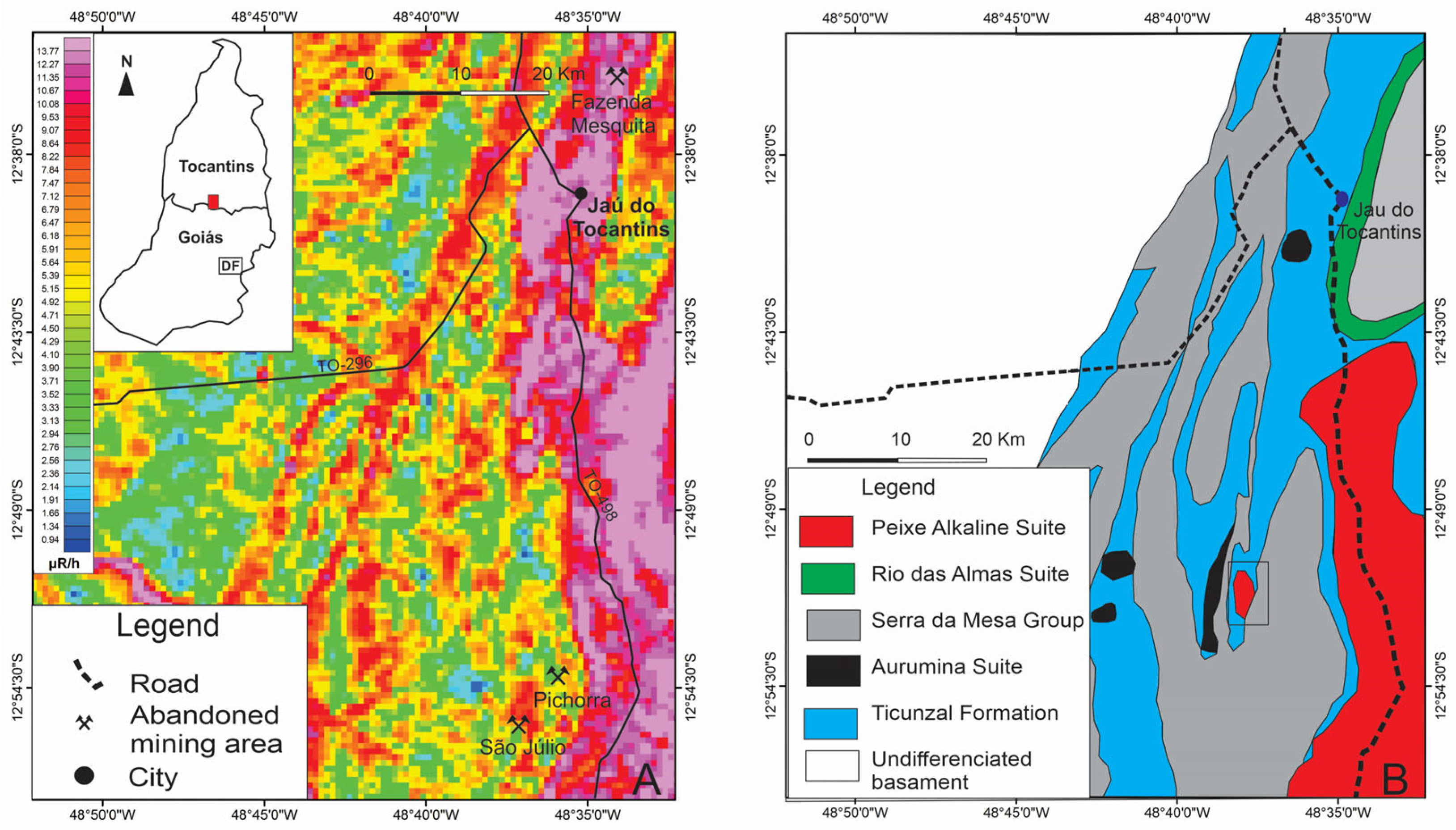
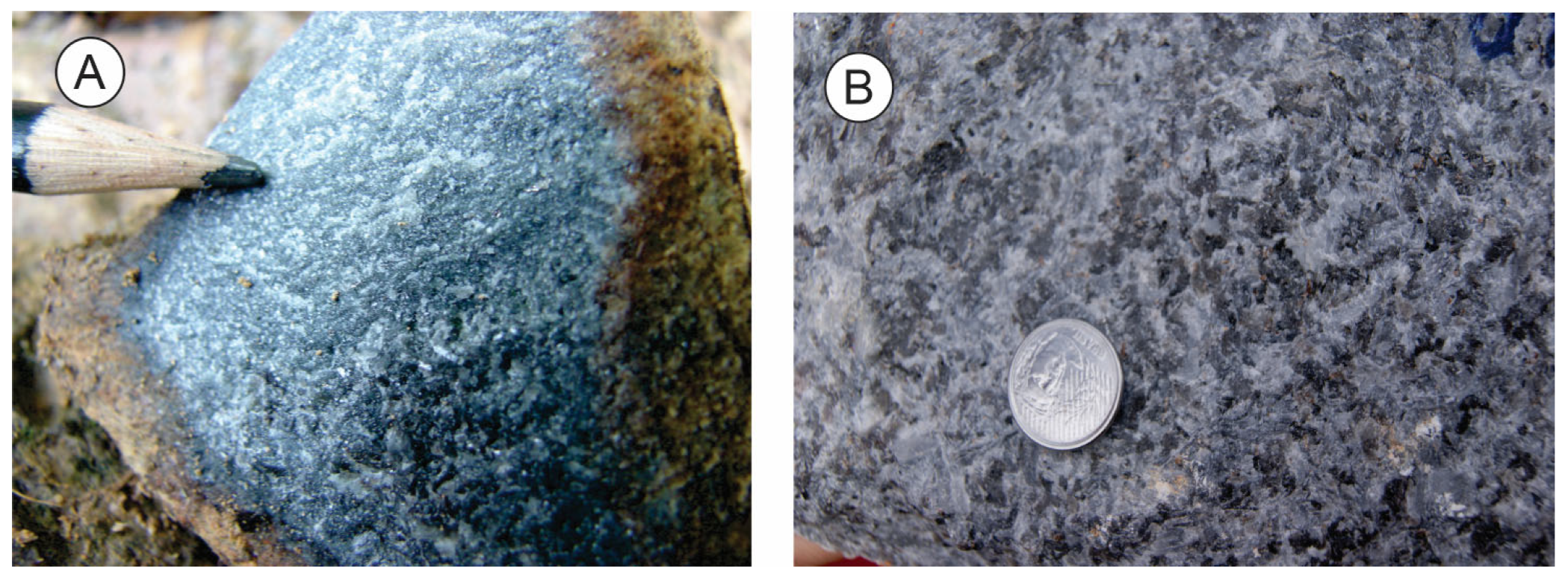
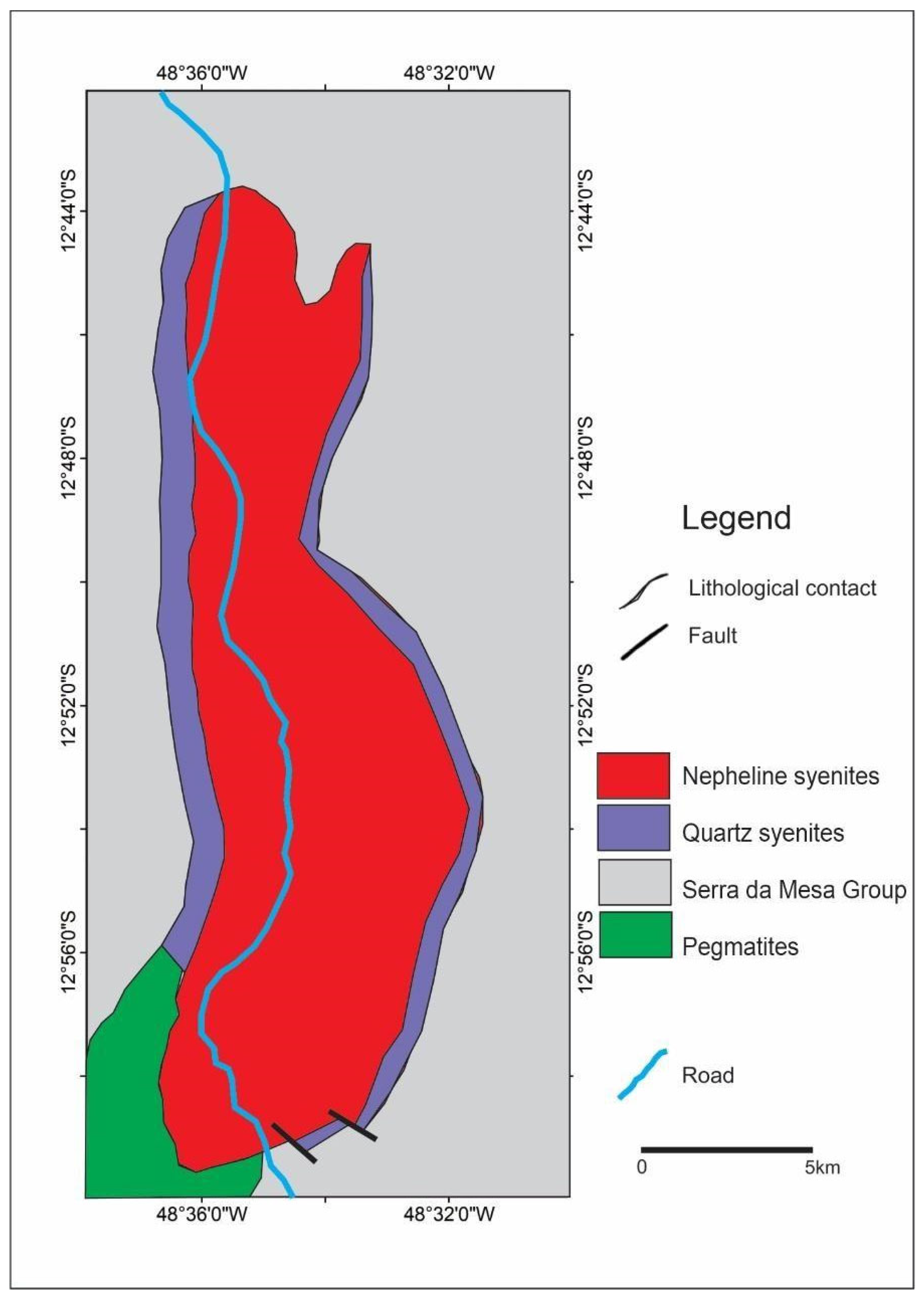
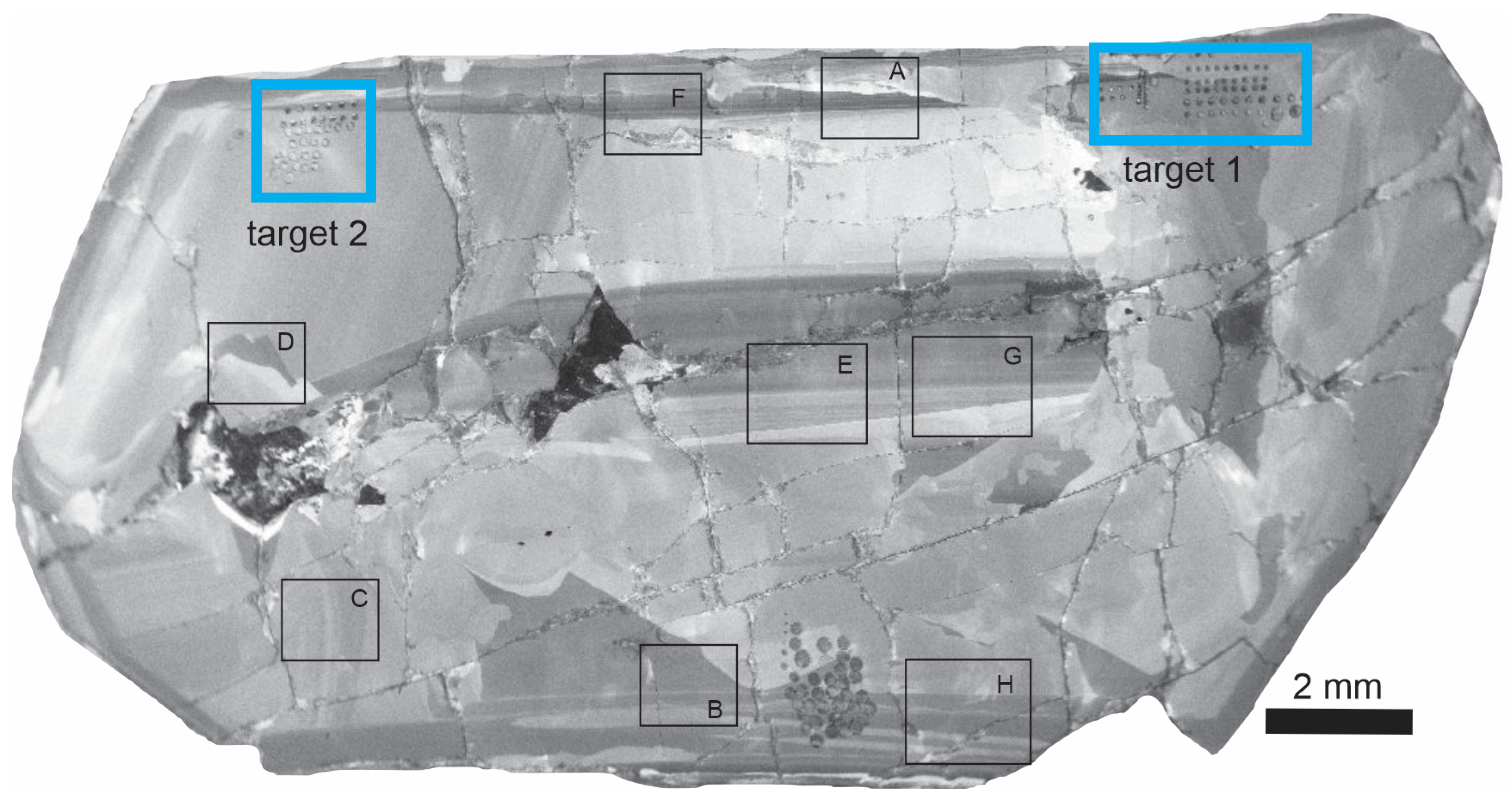
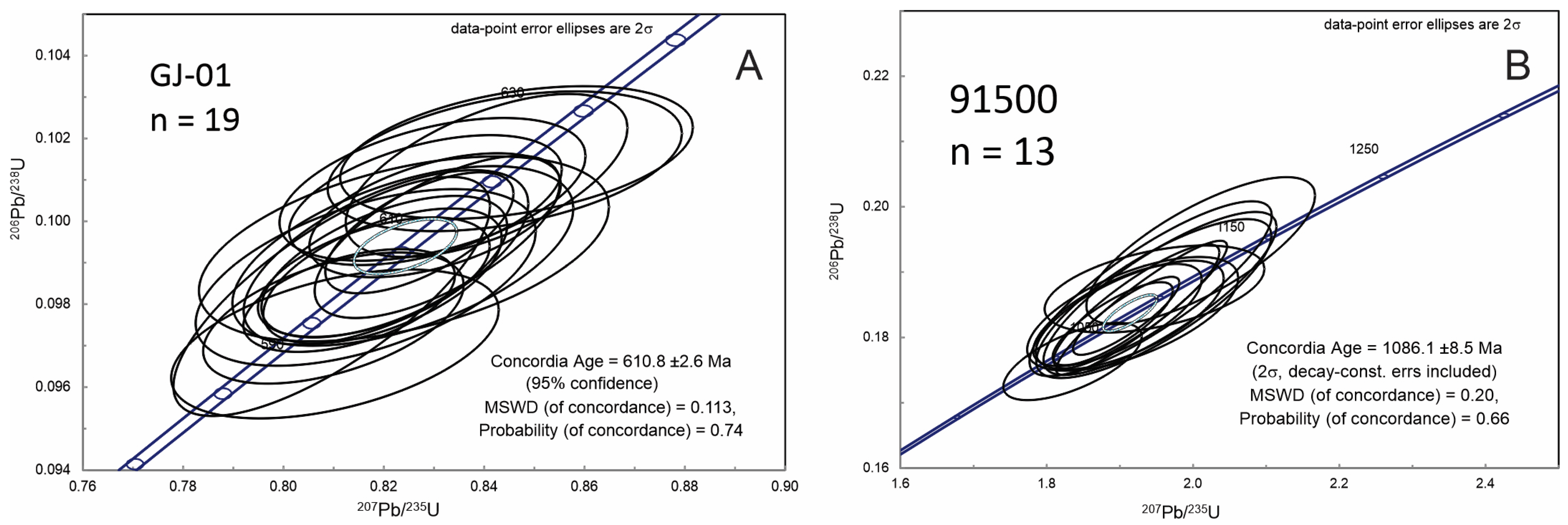
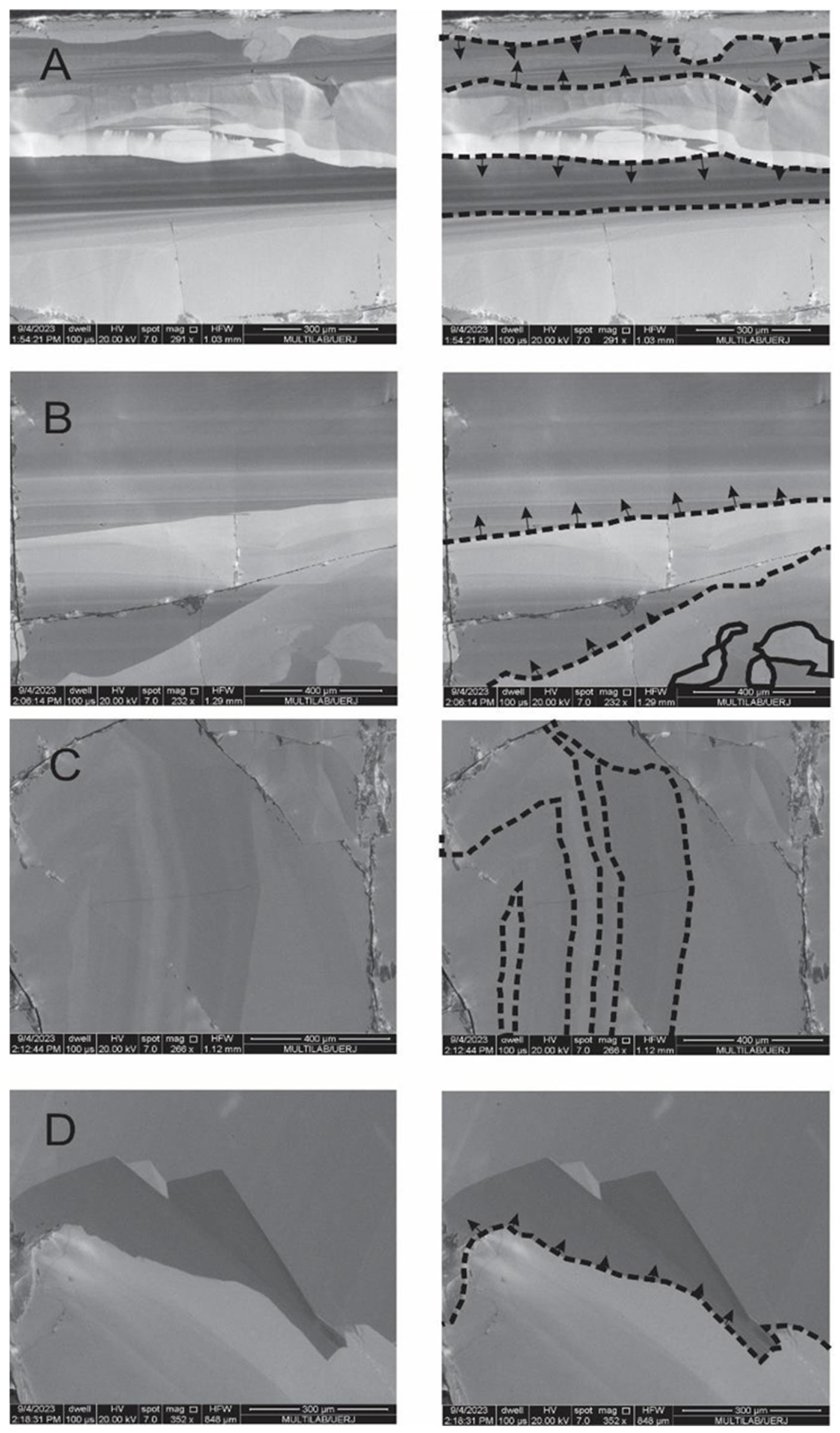
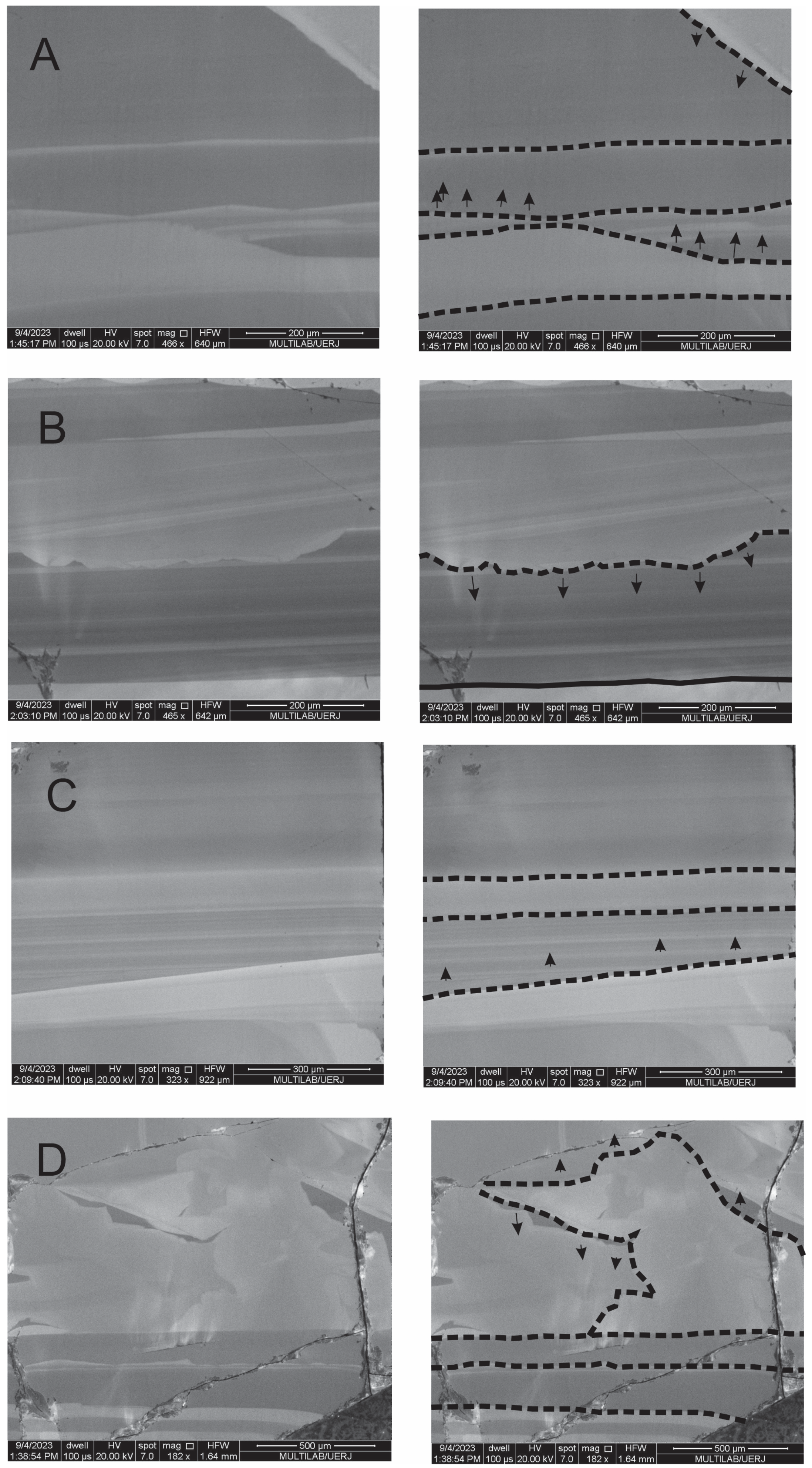
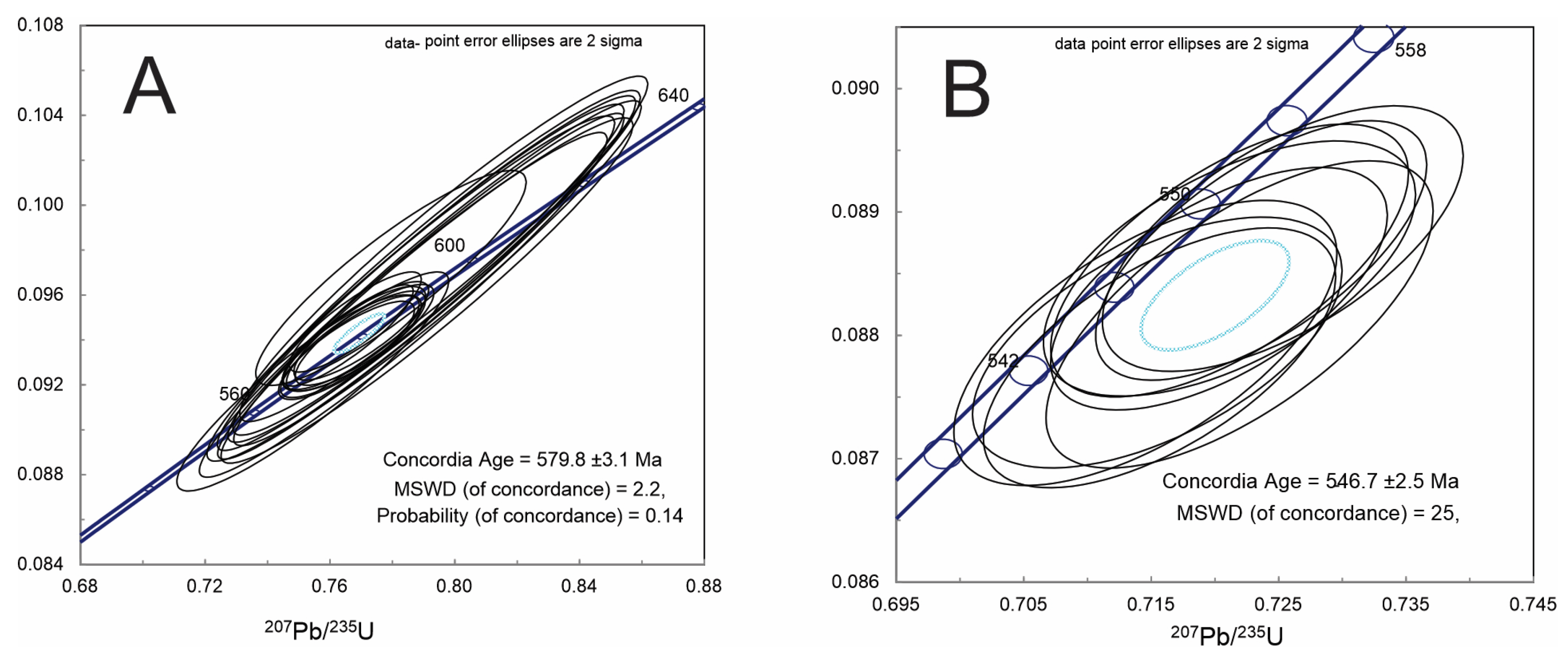
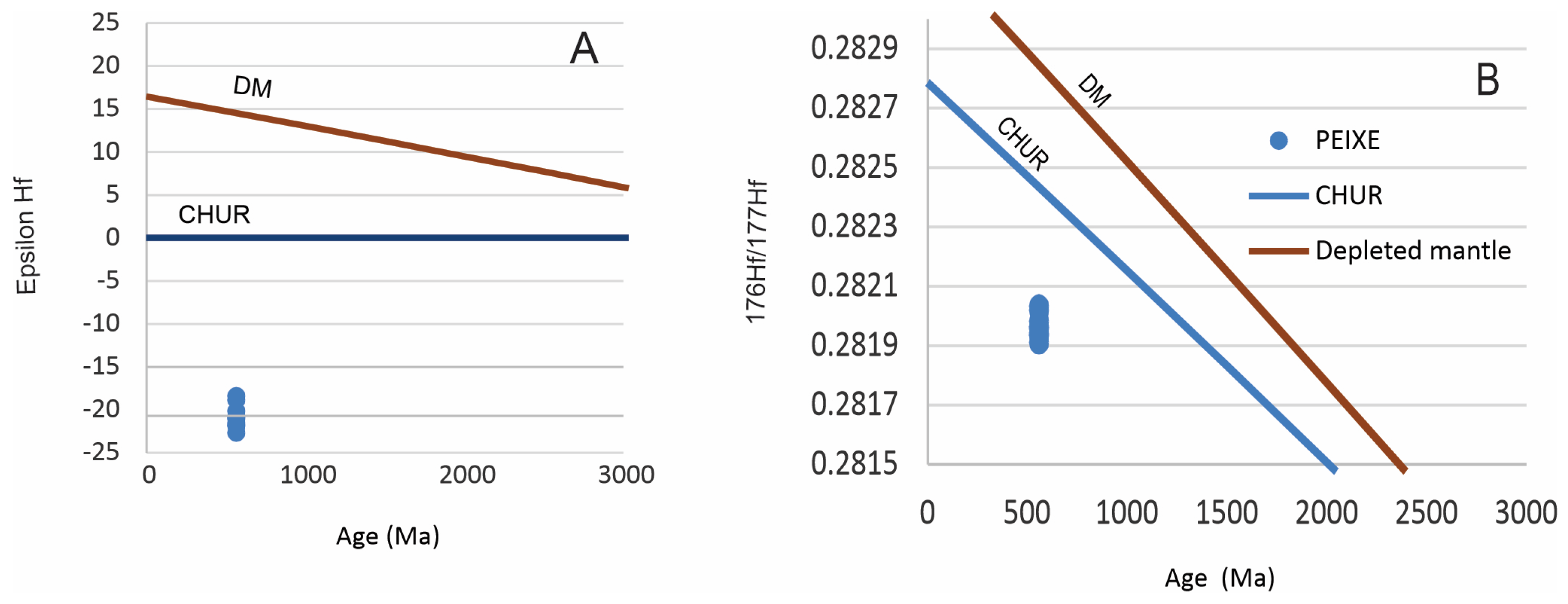
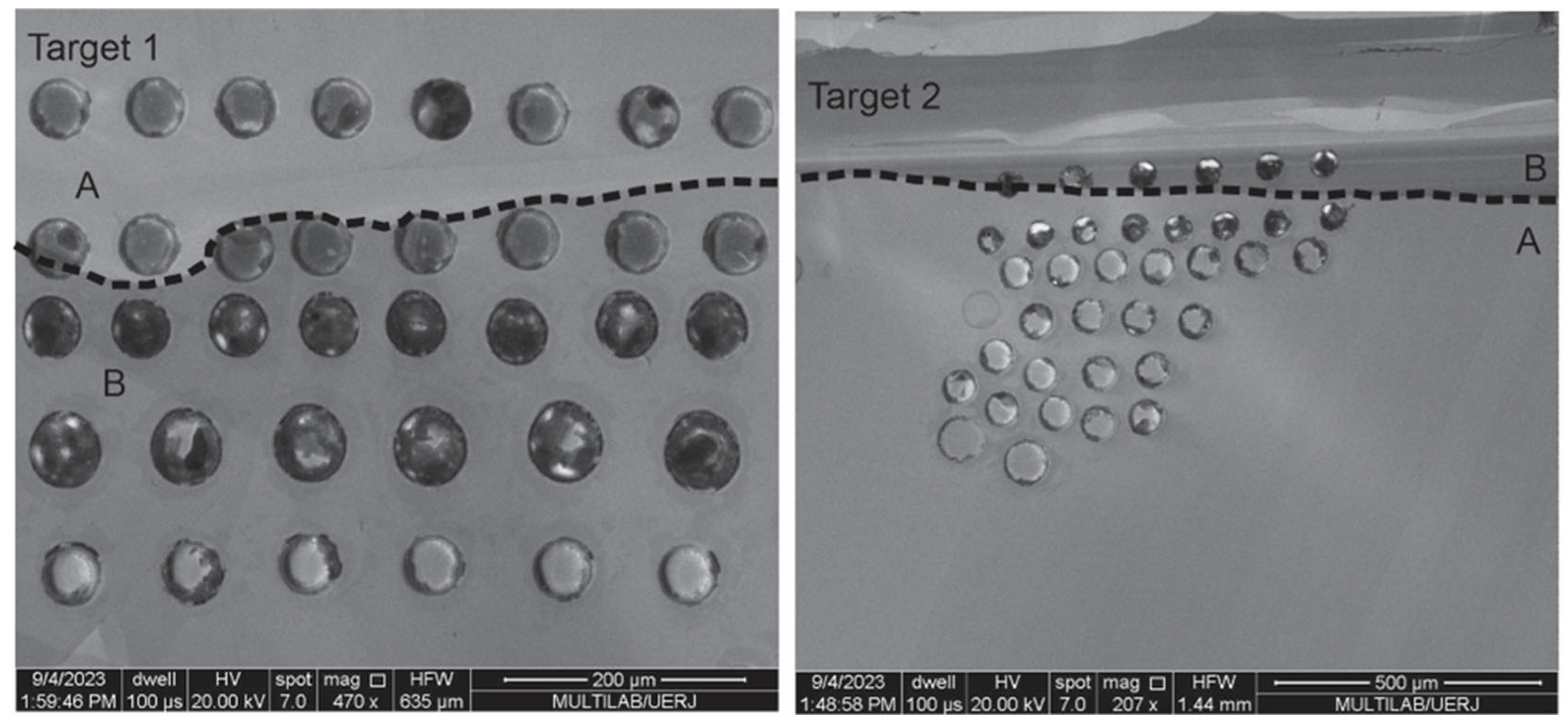
| Peixe Zircon Gray Area | Isotope Ratios | Age (Ma) | Ages (Ma) | Ages (Ma) | |||||||||||||||
|---|---|---|---|---|---|---|---|---|---|---|---|---|---|---|---|---|---|---|---|
| Spot Number | Pb | Th | U | 207Pb/ | 1 s | 206Pb/ | 1 s | 207Pb/ | 1 s | 206Pb/ | 1 s | 207Pb/ | 1 s | 207Pb/ | 1 s | % | |||
| ƒ 206a | ppm | ppm | ppm | Th/Ub | 235U | [%] | 238U | [%] | Rho | 206P | [%] | 238U | abs | 235U | abs | 206Pb | abs | Concordance | |
| PEIXE 01 01 | 0.00128 | 12.99 | 19.98 | 130.81 | 0.15 | 0.765874 | 2 | 0.094199 | 2 | 0.88 | 0.058967 | 1 | 580.3204 | 11 | 577.3934 | 13 | 565.8919 | 6 | 103 |
| PEIXE 01 02 | 0.001796 | 9.68 | 11.47 | 99.17 | 0.12 | 0.768137 | 2 | 0.094797 | 2 | 0.85 | 0.058768 | 1 | 583.8473 | 11 | 578.6935 | 13 | 558.5119 | 7 | 105 |
| PEIXE 01 03 | 0.002295 | 9.41 | 9.51 | 97.13 | 0.10 | 0.767691 | 2 | 0.094083 | 2 | 0.82 | 0.05918 | 1 | 579.6388 | 12 | 578.4372 | 14 | 573.7207 | 8 | 101 |
| PEIXE 01 04 | 0.001522 | 13.59 | 20.06 | 138.12 | 0.15 | 0.770034 | 2 | 0.094401 | 2 | 0.83 | 0.059161 | 1 | 581.5109 | 11 | 579.7827 | 13 | 573.0175 | 7 | 101 |
| PEIXE 01 05 | 0.001134 | 13.57 | 18.08 | 138.52 | 0.13 | 0.76638 | 2 | 0.093697 | 2 | 0.83 | 0.059322 | 1 | 577.3658 | 11 | 577.6842 | 14 | 578.9366 | 8 | 100 |
| PEIXE 01 06 | 0.001204 | 12.49 | 16.35 | 127.61 | 0.13 | 0.771073 | 2 | 0.094226 | 2 | 0.83 | 0.05935 | 1 | 580.4806 | 11 | 580.3781 | 14 | 579.9768 | 8 | 100 |
| PEIXE 01 07 | 0.00155 | 10.89 | 14.15 | 111.44 | 0.13 | 0.768319 | 2 | 0.093945 | 2 | 0.82 | 0.059315 | 1 | 578.8269 | 11 | 578.7981 | 14 | 578.6849 | 8 | 100 |
| PEIXE 01 08 | 0.001202 | 11.05 | 14.41 | 113.36 | 0.13 | 0.765302 | 2 | 0.093534 | 2 | 0.82 | 0.059342 | 1 | 576.4049 | 11 | 577.0646 | 13 | 579.6629 | 8 | 99 |
| PEIXE 01 09 | 0.002108 | 9.97 | 12.98 | 102.25 | 0.13 | 0.766982 | 2 | 0.093867 | 2 | 0.78 | 0.059261 | 1 | 578.3648 | 11 | 578.0303 | 14 | 576.7154 | 9 | 100 |
| PEIXE 02 01 | 0.002326 | 8.17 | 7.05 | 83.15 | 0.08 | 0.796508 | 7 | 0.098054 | 6 | 0.95 | 0.058914 | 2 | 602.9963 | 39 | 594.8567 | 40 | 563.9373 | 11 | 107 |
| PEIXE 02 02 | 0.001926 | 8.28 | 7.13 | 85.01 | 0.08 | 0.789097 | 7 | 0.096784 | 7 | 0.96 | 0.059132 | 2 | 595.5353 | 39 | 590.6596 | 40 | 571.971 | 10 | 104 |
| PEIXE 02 03 | 0.002426 | 8.58 | 7.22 | 88.01 | 0.08 | 0.792702 | 7 | 0.097158 | 6 | 0.96 | 0.059174 | 2 | 597.7337 | 39 | 592.7034 | 40 | 573.4936 | 11 | 104 |
| PEIXE 02 04 | 0.001543 | 8.75 | 7.15 | 89.92 | 0.08 | 0.794221 | 7 | 0.097435 | 6 | 0.96 | 0.059119 | 2 | 599.3599 | 39 | 593.5633 | 40 | 571.4688 | 11 | 105 |
| PEIXE 02 05 | 0.001796 | 9.20 | 7.72 | 94.94 | 0.08 | 0.789149 | 7 | 0.096387 | 7 | 0.97 | 0.05938 | 2 | 593.198 | 39 | 590.689 | 40 | 581.0615 | 10 | 102 |
| PEIXE 02 06 | 0.00249 | 9.52 | 8.58 | 97.83 | 0.09 | 0.791134 | 7 | 0.096199 | 7 | 0.96 | 0.059646 | 2 | 592.0952 | 39 | 591.815 | 40 | 590.7411 | 12 | 100 |
| PEIXE 02 07 | 0.002126 | 9.87 | 8.88 | 101.90 | 0.09 | 0.785935 | 7 | 0.096287 | 7 | 0.96 | 0.0592 | 2 | 592.6114 | 39 | 588.8632 | 40 | 574.4424 | 11 | 103 |
| PEIXE 02 08 | 0.002326 | 9.84 | 8.84 | 101.94 | 0.09 | 0.783532 | 7 | 0.095561 | 7 | 0.96 | 0.059467 | 2 | 588.3418 | 39 | 587.496 | 40 | 584.2294 | 11 | 101 |
| PEIXE 02 09 | 0.002625 | 9.40 | 8.35 | 96.72 | 0.09 | 0.794488 | 7 | 0.096972 | 6 | 0.96 | 0.059421 | 2 | 596.6382 | 39 | 593.7144 | 40 | 582.5577 | 11 | 102 |
| PEIXE 03 01 | 0.001581 | 8.37 | 8.29 | 85.09 | 0.10 | 0.779556 | 5 | 0.09676 | 4 | 0.89 | 0.058432 | 2 | 595.3944 | 24 | 585.2302 | 27 | 545.9909 | 11 | 109 |
| PEIXE 03 02 | 0.002829 | 9.03 | 9.46 | 97.01 | 0.10 | 0.754525 | 5 | 0.09215 | 4 | 0.92 | 0.059385 | 2 | 568.2373 | 25 | 570.8465 | 27 | 581.2516 | 11 | 98 |
| PEIXE 04 01 | 0.002108 | 9.64 | 9.24 | 100.22 | 0.09 | 0.835236 | 43 | 0.094699 | 9 | 0.22 | 0.063968 | 42 | 583.2703 | 54 | 616.5134 | 263 | 740.5632 | 308 | 79 |
| PEIXE 04 02 | 0.002326 | 8.92 | 8.95 | 94.34 | 0.09 | 0.822243 | 43 | 0.093251 | 9 | 0.22 | 0.063951 | 42 | 574.7344 | 54 | 609.2991 | 260 | 740.005 | 308 | 78 |
| PEIXE 04 03 | 0.001926 | 8.91 | 9.24 | 95.47 | 0.10 | 0.798328 | 44 | 0.09303 | 9 | 0.21 | 0.062238 | 43 | 573.4307 | 54 | 595.8847 | 261 | 682.3081 | 292 | 84 |
| PEIXE 04 04 | 0.002829 | 8.72 | 9.32 | 94.03 | 0.10 | 0.819438 | 42 | 0.092291 | 9 | 0.22 | 0.064396 | 41 | 569.0715 | 54 | 607.7351 | 258 | 754.6507 | 312 | 75 |
| PEIXE 04 05 | 0.002326 | 9.02 | 9.25 | 93.58 | 0.10 | 0.844645 | 43 | 0.095663 | 9 | 0.21 | 0.064037 | 42 | 588.9425 | 54 | 621.706 | 265 | 742.843 | 309 | 79 |
| PEIXE 04 06 | 0.002829 | 13.13 | 14.30 | 136.38 | 0.10 | 0.842121 | 43 | 0.095999 | 9 | 0.21 | 0.063622 | 42 | 590.9193 | 54 | 620.3153 | 266 | 729.0821 | 305 | 81 |
| PEIXE 04 07 | 0.002326 | 12.62 | 13.31 | 133.96 | 0.10 | 0.799636 | 44 | 0.094321 | 9 | 0.21 | 0.061487 | 43 | 581.0402 | 54 | 596.6233 | 264 | 656.3165 | 284 | 89 |
| PEIXE 04 08 | 0.002829 | 9.25 | 9.50 | 97.84 | 0.10 | 0.818945 | 44 | 0.095001 | 9 | 0.22 | 0.062521 | 43 | 585.0473 | 55 | 607.4594 | 265 | 691.9693 | 295 | 85 |
| PEIXE 04 09 | 0.002295 | 11.78 | 11.97 | 124.28 | 0.10 | 0.820754 | 43 | 0.093828 | 9 | 0.22 | 0.063442 | 42 | 578.1395 | 54 | 608.469 | 262 | 723.0823 | 304 | 80 |
| Peixe zircon white area | Isotope ratios | Age (Ma) | Ages (Ma) | Ages (Ma) | |||||||||||||||
| Spot number | Pb | Th | U | 207Pb/ | 1 s | 206Pb/ | 1 s | 207Pb/ | 1 s | 206Pb/ | 1 s | 207Pb/ | 1 s | 207Pb/ | 1 s | % | |||
| ƒ 206 | ppm | ppm | ppm | Th/U | 235U | [%] | 238U | [%] | Rho | 206 | [%] | 238U | abs | 235U | abs | 206Pb | abs | Concordance | |
| Peixe zircon grain Area B | |||||||||||||||||||
| PEIXE110_001 | 0.120321 | 21.72 | 6.144 | 0.050 | 0.305 | 0.72906 | 3 | 0.08801 | 2 | 0.61 | 0.06008 | 2 | 543.7572 | 9 | 606.4575 | 49 | 556.0014 | 12 | 98 |
| PEIXE110_004 | 0.008418 | 21.44 | 5.624 | 0.043 | 0.244 | 0.721924 | 3 | 0.08828 | 2 | 0.61 | 0.05931 | 2 | 545.3568 | 9 | 578.4941 | 48 | 551.8021 | 12 | 99 |
| PEIXE110_005 | 0.061995 | 21.73 | 5.710 | 0.041 | 0.235 | 0.724215 | 3 | 0.08811 | 2 | 0.61 | 0.059613 | 2 | 544.3497 | 9 | 589.5583 | 48 | 553.1524 | 12 | 98 |
| PEIXE110_005 | 0.015388 | 19.60 | 6.108 | 0.053 | 0.321 | 0.724666 | 3 | 0.08887 | 2 | 0.61 | 0.05914 | 2 | 548.8507 | 9 | 572.2537 | 49 | 553.4176 | 12 | 99 |
| PEIXE110_001 | 0.037668 | 18.53 | 5.180 | 0.066 | 0.339 | 0.728911 | 3 | 0.08999 | 2 | 0.62 | 0.058746 | 2 | 555.478 | 9 | 557.6993 | 48 | 555.9139 | 12 | 100 |
| PEIXE110_002 | 0.041611 | 19.88 | 5.612 | 0.058 | 0.326 | 0.715277 | 3 | 0.08912 | 2 | 0.62 | 0.05821 | 2 | 550.3306 | 9 | 537.6749 | 47 | 547.8747 | 12 | 100 |
| PEIXE110_003 | 0.147657 | 16.88 | 4.728 | 0.070 | 0.333 | 0.7264 | 3 | 0.08982 | 2 | 0.62 | 0.058655 | 2 | 554.4725 | 9 | 554.2971 | 49 | 554.4381 | 12 | 100 |
| PEIXE110_004 | 0.137561 | 20.09 | 5.728 | 0.054 | 0.307 | 0.714827 | 3 | 0.08824 | 2 | 0.62 | 0.058754 | 2 | 545.1198 | 9 | 557.9766 | 48 | 547.6085 | 12 | 100 |
| PEIXE110_005 | 0.07312 | 20.32 | 5.781 | 0.051 | 0.292 | 0.71738 | 3 | 0.08841 | 2 | 0.63 | 0.05885 | 2 | 546.1268 | 9 | 561.5514 | 47 | 549.1189 | 12 | 99 |
| PEIXE110_002 | 0.013023 | 24.97 | 7.181 | 0.026 | 0.184 | 0.720987 | 3 | 0.08656 | 2 | 0.62 | 0.06041 | 2 | 535.1603 | 9 | 618.292 | 47 | 551.2493 | 12 | 97 |
| PEIXE110_004 | 0.001138 | 25.84 | 7.420 | 0.027 | 0.197 | 0.726134 | 3 | 0.08669 | 2 | 0.61 | 0.06075 | 2 | 535.9315 | 9 | 630.3941 | 48 | 554.2814 | 12 | 97 |
| Sample (Present Day Ratios) | Chur | DM | Sample Initial Ratios | ||||||||||
|---|---|---|---|---|---|---|---|---|---|---|---|---|---|
| Name | U/Pb Age (Ma) | ±2 s | 176Hf/177Hf | ±2SE | 176Lu/177Hf | ±2SE | 176Hf/177Hf (t) | 176Hf/177Hf (t) | 176Hf/177Hf (t) | eHf(0) | eHf(t) | ±2SE | T DM Crustal |
| White Area | |||||||||||||
| PEIXE_20 | 580 | 3 | 0.28204 | 0.000549 | 0.001326 | 9.99 × 10−6 | 0.282323 | 0.282716 | 0.282021 | −26.357 | −10.6702 | 0.109901 | 2.128 |
| PEIXE_21 | 580 | 3 | 0.282004 | 0.0003 | 0.001367 | 1.16 × 10−5 | 0.282323 | 0.282716 | 0.281985 | −27.6227 | −11.9577 | 0.124416 | 2.200 |
| PEIXE_22 | 580 | 3 | 0.282054 | 0.000231 | 0.001353 | 1.95 × 10−5 | 0.282323 | 0.282716 | 0.282036 | −25.8391 | −10.1646 | 0.163178 | 2.100 |
| PEIXE_23 | 580 | 3 | 0.281983 | 0.000145 | 0.001199 | 1.95 × 10−5 | 0.282323 | 0.282716 | 0.281966 | −28.3757 | −12.63 | 0.222312 | 2.238 |
| PEIXE_24 | 580 | 3 | 0.281982 | 8.29 × 10−5 | 0.001187 | 1.57 × 10−5 | 0.282323 | 0.282716 | 0.281966 | −28.388 | −12.6364 | 0.181189 | 2.238 |
| PEIXE_25 | 580 | 3 | 0.281976 | 6.64 × 10−5 | 0.001175 | 1.16 × 10−5 | 0.282323 | 0.282716 | 0.28196 | −28.6133 | −12.8562 | 0.140178 | 2.251 |
| PEIXE_26 | 580 | 3 | 0.281956 | 5.27 × 10−5 | 0.00126 | 1.92 × 10−5 | 0.282323 | 0.282716 | 0.281939 | −29.3126 | −13.5981 | 0.221017 | 2.292 |
| PEIXE_27 | 580 | 3 | 0.281955 | 4.68 × 10−5 | 0.001261 | 1.68 × 10−5 | 0.282323 | 0.282716 | 0.281937 | −29.3584 | −13.6446 | 0.195414 | 2.295 |
| PEIXE_28 | 580 | 3 | 0.281931 | 4.46 × 10−5 | 0.00124 | 8.87 × 10−7 | 0.282323 | 0.282716 | 0.281914 | −30.209 | −14.4863 | 0.024523 | 2.342 |
| PEIXE_29 | 580 | 3 | 0.281962 | 4.45 × 10−5 | 0.001174 | 8.67 × 10−6 | 0.282323 | 0.282716 | 0.281946 | −29.0887 | −13.332 | 0.111554 | 2.277 |
| PEIXE_30 | 580 | 3 | 0.282495 | 9.12 × 10−5 | 8.84 × 10−5 | 7.1 × 10−7 | 0.282323 | 0.282716 | 0.282494 | −10.2395 | 6.077072 | 0.055704 | 1.182 |
| 91500 | 1065 | 10 | 0.282314 | 0.000104 | 0.000202 | 1.57 × 10−6 | 0.28211 | 0.282471 | 0.28231 | −16.6418 | 7.093483 | 0.061696 | 1.391 |
| Gray area | U/Pb | Sample (Present Day Ratios) | Chur | DM | Sample Initial Ratios | Crustal | |||||||
| Sample | Age (Ma) | ±2s | 176Hf/177Hf | ±2 SE | 176Lu/177Hf | ±2SE | 176Hf/177Hf (t) | 176Hf/177Hf (t) | 176Hf/177Hf (t) | eHf(0) | eHf(t) | ±2SE | residence |
| 70 | 548 | 4 | 0.282038 | 5.55 × 10−5 | 0.000891 | 0.000116 | 0.282429 | 0.282839 | 0.282029 | −26.4064 | −14.1802 | 1.947836 | 1793.539 |
| 80 | 548 | 4 | 0.282012 | 5.76 × 10−5 | 0.000921 | 0.000115 | 0.282429 | 0.282839 | 0.282002 | −27.3274 | −15.1135 | 1.990984 | 1850.877 |
| 90 | 548 | 4 | 0.282061 | 7.24 × 10−5 | 0.00099 | 9.96 × 10−5 | 0.282429 | 0.282839 | 0.282051 | −25.5859 | −13.3958 | 1.447043 | 1745.301 |
| 100 | 548 | 4 | 0.281992 | 6.73 × 10−5 | 0.000952 | 0.000132 | 0.282429 | 0.282839 | 0.281982 | −28.0286 | −15.8274 | 2.312122 | 1894.694 |
| 110 | 548 | 4 | 0.281982 | 7.62 × 10−5 | 0.000899 | 0.000142 | 0.282429 | 0.282839 | 0.281973 | −28.388 | −16.1673 | 2.666763 | 1915.546 |
| 120 | 548 | 4 | 0.282021 | 8.41 × 10−5 | 0.000852 | 0.000147 | 0.282429 | 0.282839 | 0.282012 | −27.011 | −14.7709 | 2.661478 | 1829.839 |
| 130 | 548 | 4 | 0.281918 | 7.45 × 10−5 | 0.000859 | 0.00014 | 0.282429 | 0.282839 | 0.281909 | −30.6691 | −18.4363 | 3.15124 | 2054.514 |
| 140 | 548 | 4 | 0.28208 | 7.65 × 10−5 | 0.000978 | 0.000113 | 0.282429 | 0.282839 | 0.28207 | −24.9139 | −12.7185 | 1.562188 | 1703.618 |
| 150 | 548 | 4 | 0.281961 | 7.55 × 10−5 | 0.000952 | 0.000116 | 0.282429 | 0.282839 | 0.281951 | −29.1473 | −16.9474 | 2.190749 | 1963.362 |
| 160 | 548 | 4 | 0.282039 | 7.96 × 10−5 | 0.001053 | 7.65 × 10−5 | 0.282429 | 0.282839 | 0.282028 | −26.363 | −14.1975 | 1.136343 | 1794.605 |
| MUD TANK | 732 | 4 | 0.28246 | 4.32 × 10−5 | 9.65 × 10−5 | 3.5 × 10−7 | 0.282323 | 0.282716 | 0.282458 | −11.5066 | 4.803988 | 0.044398 | 577.1016 |
| 91500 | 1065 | 4 | 0.282309 | 6.93 × 10−5 | 0.000245 | 6.06 × 10−7 | 0.28211 | 0.282471 | 0.282304 | −16.8477 | 6.856493 | 0.044412 | 374.8383 |
Disclaimer/Publisher’s Note: The statements, opinions and data contained in all publications are solely those of the individual author(s) and contributor(s) and not of MDPI and/or the editor(s). MDPI and/or the editor(s) disclaim responsibility for any injury to people or property resulting from any ideas, methods, instructions or products referred to in the content. |
© 2025 by the authors. Licensee MDPI, Basel, Switzerland. This article is an open access article distributed under the terms and conditions of the Creative Commons Attribution (CC BY) license (https://creativecommons.org/licenses/by/4.0/).
Share and Cite
Coelho, M.H.; Romero, L.F.; Martins, M.V.A.; Holanda, W.; Salomão, M.; Potratz, G.L.; Tavares, A.D.; Geraldes, M.C. U-Pb and Lu-Hf Record of Two Metamorphic Events from the Peixe Alkaline Suite, Brasilia Belt: Textural and Isotopic Complexity in Zircon. Minerals 2025, 15, 274. https://doi.org/10.3390/min15030274
Coelho MH, Romero LF, Martins MVA, Holanda W, Salomão M, Potratz GL, Tavares AD, Geraldes MC. U-Pb and Lu-Hf Record of Two Metamorphic Events from the Peixe Alkaline Suite, Brasilia Belt: Textural and Isotopic Complexity in Zircon. Minerals. 2025; 15(3):274. https://doi.org/10.3390/min15030274
Chicago/Turabian StyleCoelho, Marco Helenio, Luís Felipe Romero, Maria Virginia Alves Martins, Werlem Holanda, Marcelo Salomão, Guilherme Loriato Potratz, Armando Dias Tavares, and Mauro Cesar Geraldes. 2025. "U-Pb and Lu-Hf Record of Two Metamorphic Events from the Peixe Alkaline Suite, Brasilia Belt: Textural and Isotopic Complexity in Zircon" Minerals 15, no. 3: 274. https://doi.org/10.3390/min15030274
APA StyleCoelho, M. H., Romero, L. F., Martins, M. V. A., Holanda, W., Salomão, M., Potratz, G. L., Tavares, A. D., & Geraldes, M. C. (2025). U-Pb and Lu-Hf Record of Two Metamorphic Events from the Peixe Alkaline Suite, Brasilia Belt: Textural and Isotopic Complexity in Zircon. Minerals, 15(3), 274. https://doi.org/10.3390/min15030274







